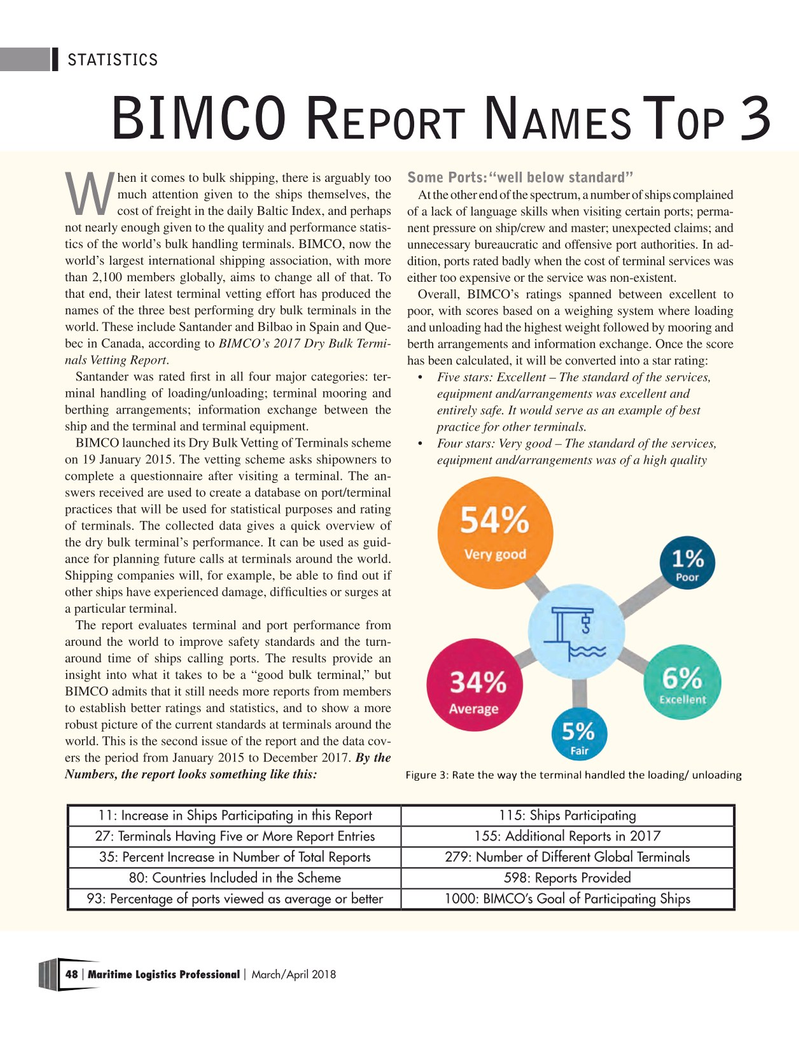
Page 48: of Maritime Logistics Professional Magazine (Mar/Apr 2018)
IT & Software
Read this page in Pdf, Flash or Html5 edition of Mar/Apr 2018 Maritime Logistics Professional Magazine
STATISTICS
BIMCO R N t 3 epORt aMes Op hen it comes to bulk shipping, there is arguably too
Some Ports: “well below standard” much attention given to the ships themselves, the At the other end of the spectrum, a number of ships complained
Wcost of freight in the daily Baltic Index, and perhaps of a lack of language skills when visiting certain ports; perma- not nearly enough given to the quality and performance statis- nent pressure on ship/crew and master; unexpected claims; and tics of the world’s bulk handling terminals. BIMCO, now the unnecessary bureaucratic and offensive port authorities. In ad- world’s largest international shipping association, with more dition, ports rated badly when the cost of terminal services was than 2,100 members globally, aims to change all of that. To either too expensive or the service was non-existent.
that end, their latest terminal vetting effort has produced the Overall, BIMCO’s ratings spanned between excellent to names of the three best performing dry bulk terminals in the poor, with scores based on a weighing system where loading world. These include Santander and Bilbao in Spain and Que- and unloading had the highest weight followed by mooring and bec in Canada, according to BIMCO’s 2017 Dry Bulk Termi- berth arrangements and information exchange. Once the score nals Vetting Report. has been calculated, it will be converted into a star rating:
Santander was rated frst in all four major categories: ter- • Five stars: Excellent – The standard of the services, minal handling of loading/unloading; terminal mooring and equipment and/arrangements was excellent and berthing arrangements; information exchange between the entir ely safe. It would serve as an example of best ship and the terminal and terminal equipment. pr actice for other terminals.
BIMCO launched its Dry Bulk Vetting of Terminals scheme • Four stars: Very good – The standard of the services, on 19 January 2015. The vetting scheme asks shipowners to equipment and/arrangements was of a high quality complete a questionnaire after visiting a terminal. The an- swers received are used to create a database on port/terminal practices that will be used for statistical purposes and rating of terminals. The collected data gives a quick overview of the dry bulk terminal’s performance. It can be used as guid- ance for planning future calls at terminals around the world.
Shipping companies will, for example, be able to fnd out if other ships have experienced damage, diffculties or surges at a particular terminal.
The report evaluates terminal and port performance from around the world to improve safety standards and the turn- around time of ships calling ports. The results provide an insight into what it takes to be a “good bulk terminal,” but
BIMCO admits that it still needs more reports from members to establish better ratings and statistics, and to show a more robust picture of the current standards at terminals around the world. This is the second issue of the report and the data cov- ers the period from January 2015 to December 2017. By the
Numbers, the report looks something like this: 11: Increase in Ships Participating in this Report 115: Ships Participating 27: Terminals Having Five or More Report Entries 155: Additional Reports in 2017 35: Percent Increase in Number of Total Reports 279: Number of Different Global Terminals 80: Countries Included in the Scheme 598: Reports Provided 93: Percentage of ports viewed as average or better 1000: BIMCO’s Goal of Participating Ships 48 Maritime Logistics Professional March/April 2018 | |

 47
47

 49
49
